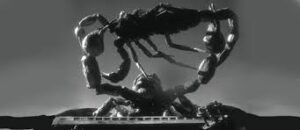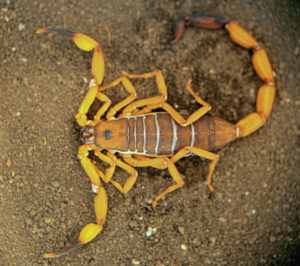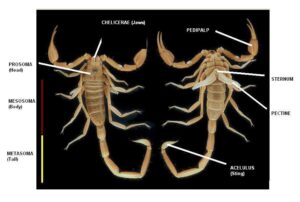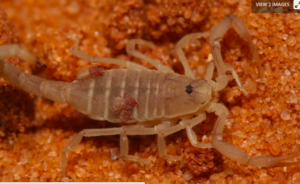February Scorpions!
Don’t know much about….Scorpions!
What do you know about scorpions? Maybe you saw a science fiction movie featuring a giant one like the one in the 1957 movie, The Black Scorpion. The plot line was simple, a volcano in Mexico opened up an underground cavern releasing giant scorpions that hunted down and ate people. Compared to modern monster movies, this one wasn’t very well animated, but as a kid, I was scared and came away from the movie thinking that scorpions were definitely something to be avoided.

Living in the desert in southern California one would think that I would have seen a number of these scary-looking arthropods, but we didn’t see many. It was probably because we were diurnal (daytime) creatures and scorpions are mostly nocturnal (night time). Unless you turn over lots of rocks or dig burrows, you probably won’t see many in the wild.
Even though I spent many years thereafter collecting insects and other arthropods, scorpions were not something I bumped into much, and when I did, I was very careful not to get to close to that stinger. Dr. Sleeper, my entomology professor, told the class that the largest of the scorpions found in the California desert, the greenish tinged Honduras, was relatively harmless, but that the smaller species, Centruroides could be deadly.
 Watch out for this one….
Watch out for this one….
I treated them all with respect knowing that a sting could cause pain and perhaps some kind of toxic aftermath. A very long forceps was the tools one would use to collect a scorpion if found under a rock.
Dr. Sleeper didn’t know a great deal about scorpions except to describe their anatomy and offer some speculations that others were asserting about their biology. He was not certain the purpose of the pectine, for example. (This is a frilly looking appendage under the sternum. See below)

Some things were rather straightforward. The walking legs were for, what else? Walking. The giant claws were for grabbing prey, the stinger was for neutralizing what they grabbed, and the chelicerae were the choppers that gobbled up the food. We had one in a terrarium under dim light and fed it a cockroach once in a while, and the behavior seemed to follow the adaptations. In re-reading the chapter on scorpions in our 1964 textbook on Arachnida, it is no wonder that I came away from college with a shallow sense of the ways and wiles of scorpions. The author summarizes what was known then by quoting the Bible, “My father disciplined you with whips, but I will discipline you with scorpions.” 1 Kings 12:14. He interprets this as a way to show how biologists are made humble wondering about scorpions.
In the last 50 years, a great deal has been learned about scorpions. One major discovery has helped to discover the thousands of different kinds of these arachnids, using black lights to find them. Under ultraviolet light, scorpions glow. Although there are different hypotheses about why they have this particular adaptation, no one is sure. Scorpions tend to avoid too much ultra violet light. They will not come out on a moonlit night if they are not really hungry. The connection between avoiding UV and fluorescing under UV is not understood. One thing is clear, if you are hunting for scorpions, get a black light and walk around at night with your long forceps!

It was once thought that scorpions only lived in warm, dry climates below the 45th parallel, but surveys show that they can live at altitudes up to 18,000 feet and in cold Alberta, Canada as well as tropical jungles. Over 2500 living species have identified thus far and 100 different fossilized specimens have been unearthed. Scorpions are found mostly in desert areas, but also found in a variety of niches such as under bark, along sea shores, and caves. The largest of species, 14 inches long, is found in the fossil record. Living species can be 8 inches or more in size and the smallest are less than a half of an inch long.
I hadn’t thought much about scorpions lay until I read an article about how one scorpion species lives with ants. They found the scorpion at night with a black light walking along a trail of ants and then climbing into the ant hole and then out again. The ants didn’t seem to notice the intruder. What was even more astonishing was that the scorpion had pseudoscorpions on its back. Pseudoscorpions look like tiny scorpions, but the lack theta and stinger. Entomologists concluded that these freeloaders were being ferried from ant hole to ant hole where they hopped off and gobbled up mites and ant larvae.





